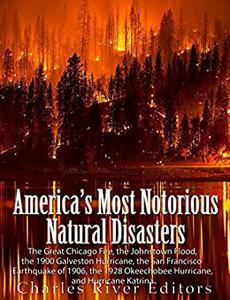America's Most Notorious Natural Disasters
- Книги
- 19-02-2023, 01:00
- 151
- 0
- voska89

America's Most Notorious Natural Disasters: The Great Chicago Fire, the Johnstown Flood, the 1900 Galveston Hurricane, the San Francisco Earthquake of ... Okeechobee Hurricane, and Hurricane Katrina by Charles River Editors
English | February 27, 2018 | ISBN: 1986037924 | 309 pages | EPUB | 9.98 Mb
*Includes pictures *Includes contemporary accounts of the disasters *Includes a bibliography for further reading It had taken about 40 years for Chicago to grow from a small settlement of about 300 people into a thriving metropolis with a population of 300,000, but in just two days in 1871, much of that progress was burned to the ground. In arguably the most famous fire in American history, a blaze in the southwestern section of Chicago began to burn out of control on the night of October 8, 1871. Thanks to The Chicago Tribune, the fire has been apocryphally credited to a cow kicking over a lantern in Mrs. Catherine O'Leary's barn, and though that was not true, the rumor dogged Mrs. O'Leary to the grave. Although floods rarely get as much coverage as other kinds of natural disasters like volcanic explosions, the Johnstown Flood of 1889 has remained an exception due to the sheer destruction and magnitude of the disaster. On May 31, 1889, Johnstown became a casualty of a combination of heavy rains and the failure of the South Fork Dam to stem the rising water levels of Lake Conemaugh about 15 miles away. The flood ultimately resulted in the deaths of over 2,000 people and destroyed thousands of buildings, wreaking damages estimated to be the equivalent of nearly half a billion dollars today. As bad as Hurricane Katrina was, the hurricane that struck Galveston, Texas on September 8, 1900 killed several times more people, with an estimated death toll between 6,000-12,000 people. Prior to advanced communications, few people knew about impending hurricanes except those closest to the site, and in the days before television, or even radio, catastrophic descriptions were merely recorded on paper, limiting an understanding of the immediate impact. The second deadliest hurricane in American history claimed 2,500 lives, so it's altogether possible that the Galveston hurricane killed over 4 times more than the next deadliest in the U.S. To this day, it remains the country's deadliest natural disaster. On April 18, 1906, most of the residents of the city of San Francisco were sound asleep when the ground started to shake around 5:15 a.m., but what started as fairly soft tremors turned into a violent shaking in all directions. The roar of the earthquake unquestionably woke up residents, at least those fortunate enough not to be immediately swallowed by the cracks opening up in the ground. The earthquake lasted about a minute, but it had enough destructive force to divert the course of entire rivers and level much of the 9th largest city in America at the time. Although the resulting fires may have done the most damage, the widespread destruction made clear to city leaders that the new buildings would need better safety codes and protection against subsequent earthquakes. Given the lack of warning and the lack of technology in the early 20th century, it was inevitable that a Category 5 hurricane wrought almost inconceivable destruction in 1928 as it made landfall in Florida with winds at nearly 150 miles per hour. And in addition to the powerful storm itself, the flooding of Lake Okeechobee, the 7th largest freshwater lake in the country, exacerbated the damage by spilling across several hundred square miles, which were covered in up to 20 feet of water in some places. Most hurricanes of the 21st century take fewer lives than a serious highway accident. As such, the world watched in horror as Hurricane Katrina decimated New Orleans in August 2005, and the calamity seemed all the worse because many felt that technology had advanced far enough to prevent such tragedies, whether through advanced warning or engineering. Spawning off the Bahamian coast that month, Katrina quickly grew to be one of the deadliest natural disasters in American history, killing more than 1,800 people and flooding a heavy majority of one of America's most famous cities.
Links are Interchangeable - No Password - Single Extraction


